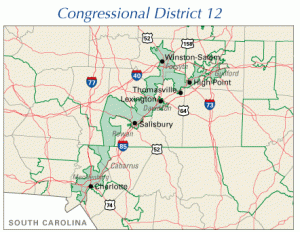NC 12th Congressional District
Democratic Party
The NC 12th Congressional District
North Carolina's 12th congressional district is located in central North Carolina and comprises portions of Charlotte, Winston-Salem, Greensboro, Lexington, Salisbury, Concord, and High Point. It was one of two minority-majority Congressional districts created in the state in the 1990s. Since the 2000 census, it has had a small plurality of whites, though blacks make up a majority of its voting population.
The district was re-established after the 1990 United States Census, when North Carolina gained a House seat due to an increase in population. It was drawn in 1992 as one of two black majority (minority-majority) districts, designed to give blacks (who comprised 22% of the state's population at the time) the chance to elect a representative of their choice under Section 2 of the Voting Rights Act, which prohibited dilution of voting power of minorities.[2] In its original configuration, this was a 64 percent black-majority district stretching from Gastonia to Durham. It was very long and so thin at some points that it was no wider than a highway lane, as it followed Interstate 85 almost exactly.[3][4]
It was criticized as a racially gerrymandered district. For instance, the Wall Street Journal described the district "political pornography." The United States Supreme Court ruled inShaw v. Reno, 509 U.S. 630 (1993) that a racial gerrymander may, in some circumstances, violate the Equal Protection Clause.
The state legislature had defended the two minority-majority districts as based on demographics, with the 12th representing the interior Piedmont area and the 1st the Coastal Plain.[2] Subsequently, the 12th district was redrawn several times and was adjudicated in the Supreme Court on two additional occasions.[2] The version created after the 2000 census was approved by the US Supreme Court in Hunt v. Cromartie. The current version dates from the 2010 census; like the 2003-2013 version, it has a small plurality of whites. Blacks make up a large majority of registered voters and Hispanics constitute 7.1% of residents. In all its configurations, it has been a Democratic stronghold dominated by black voters in Charlotte and the Piedmont Triad.

